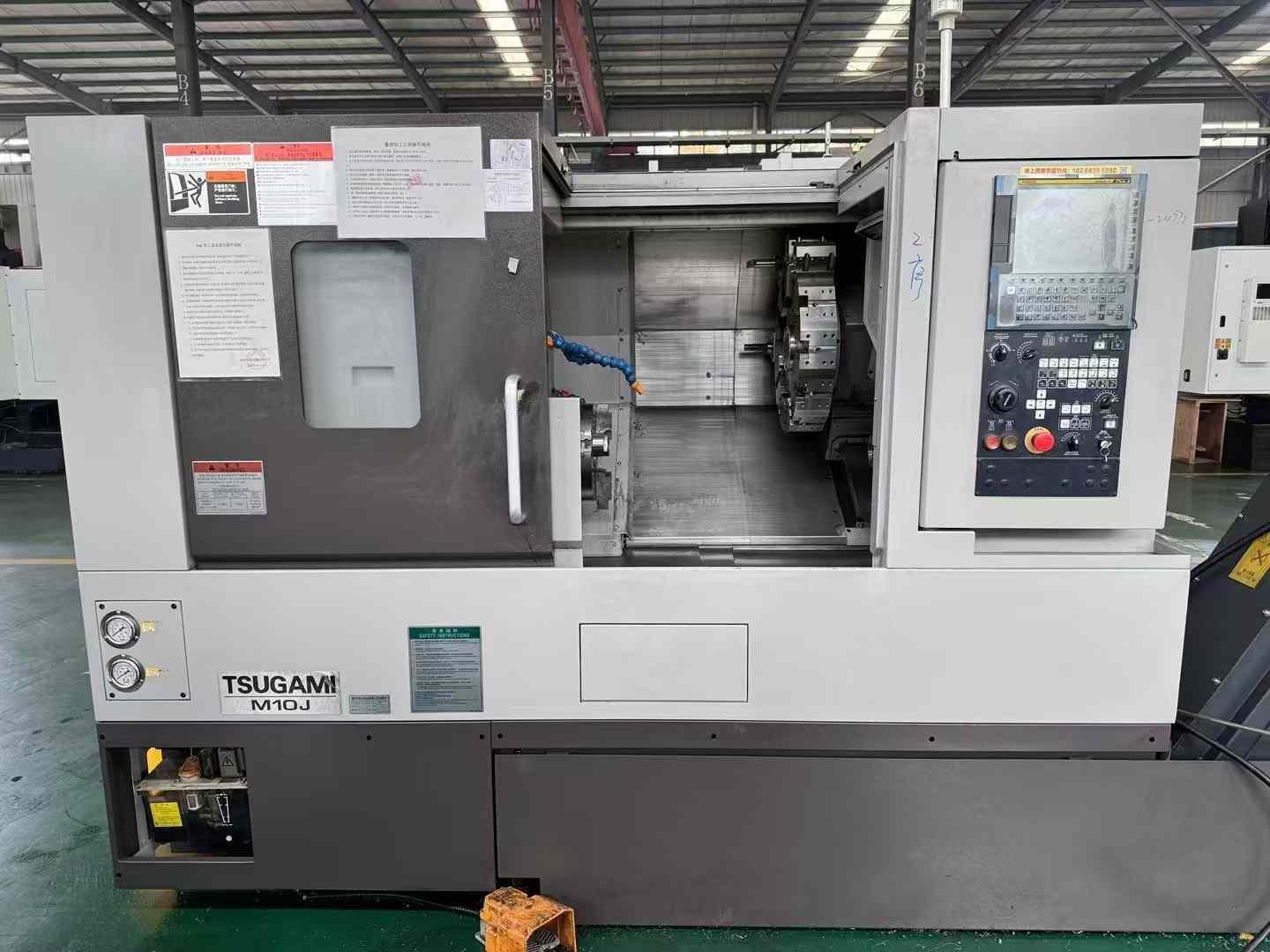What should be noted when purchasing a second-hand CNC lathe?
When purchasing a second-hand CNC lathe, the following precautions should be taken:
1. Equipment performance inspection
Accuracy testing
-Geometric accuracy: This is the most basic accuracy indicator for CNC lathes, including the spindle rotation accuracy (such as radial runout and axial displacement), guide rail straightness, bed flatness, etc. For example, the radial runout of the spindle directly affects the roundness of the machined part, and it is generally required that the radial runout of the spindle of a regular CNC lathe be within 0.01-0.02mm. Measurement can be carried out using tools such as a dial gauge. The dial gauge is fixed on the bed, and the head contacts the surface of the spindle or guide rail. The spindle can be rotated or the slide box can be moved to detect jumping or straightness.
-Positioning accuracy and repeat positioning accuracy: Positioning accuracy refers to the degree to which the actual position of the moving parts of the lathe (such as the tool holder) is close to the commanded position, while repeat positioning accuracy reflects the dispersion of positions when positioning multiple times under the same conditions. For precision machining, the positioning accuracy should reach ± 0.01- ± 0.03mm, and the repeated positioning accuracy should be around ± 0.005- ± 0.01mm. It can be measured using professional equipment such as laser interferometers, or simple testing can be performed using the diagnostic function of CNC systems.
Processing capability test
-Cutting performance: Check the cutting performance of the lathe through trial cutting, observe whether the cutting process is smooth, whether there is vibration, excessive noise, etc. Choose appropriate cutting tools and workpiece materials for trial cutting, such as using hard alloy cutting tools to cut 45 steel, setting reasonable cutting parameters (speed, feed rate, cutting depth). Under normal circumstances, cutting should be smooth, and the surface roughness can meet the expected requirements (for example, the surface roughness Ra of ordinary turning machining can reach 1.6-3.2 μ m).
-Maximum machining size and weight: Confirm whether the maximum machining diameter, length, and maximum load-bearing capacity of the lathe meet your machining needs. Check the specifications of the equipment and make judgments based on the actual processed workpiece to avoid purchasing parts that cannot be processed with the required size and weight.
System function check
-Control system integrity: Check whether the various functional modules of the CNC system are complete, such as programming function, automatic machining function, tool compensation function, etc. For example, for the processing of complex parts, a CNC system with rich programming instructions (such as arc interpolation, thread cutting, etc.) is required. At the same time, check whether the buttons, knobs, etc. on the system's operation panel are working properly, and whether the display screen is clear and undamaged.
-Communication interface testing: If data transmission with external devices (such as computer-aided manufacturing software CAM) is required, the communication interface (such as RS-232, USB, etc.) should be tested for normal operation. Attempt to transmit a simple machining program and see if it can be received and executed smoothly.
2. Equipment quality assessment
Appearance inspection
-Body condition: Check whether there are obvious signs of damage such as collision, deformation, cracks, etc. on the lathe body. The integrity of the machine body is crucial for maintaining the stability and accuracy of the lathe. For example, if there are cracks in the bed, it may cause deformation of the bed during the machining process, thereby affecting the machining accuracy.
-Paint and protective layer: Check if the paint has peeled off and if the protective layer is intact. Paint peeling may be a sign of long-term exposure to harsh environments or corrosion of equipment, which may affect its service life.
Component inspection
-Wear of key components: Focus on inspecting the wear of key components such as the spindle, guide rail, ball screw, and tool holder. For example, wear and tear on the guide rail can cause uneven movement of the slide box, affecting machining accuracy. The degree of wear can be determined by observing the smoothness of the surface of the component, whether there are scratches, and manually moving the component to feel the smoothness of its movement. For ball screws, it is also possible to check if their axial clearance is within a reasonable range.
-Electrical and hydraulic systems: Check the wiring of the electrical system for neatness, damage, aging, and other conditions. Check whether the identification of electrical components (such as contactors, relays, motors, etc.) is clear and whether they are working properly. For hydraulic systems, check the oil level in the tank, the working condition of the oil pump, and whether there are leaks in the oil pipes. The stability of the pressure in the hydraulic system is crucial for some lathes equipped with hydraulic chucks, tailstock, and other devices.
3. Equipment history investigation
Service life and frequency
-Determination of service life: Understand the service life of the lathe. Generally speaking, equipment with a shorter service life has better performance and accuracy. But this is not absolute, it still needs to be judged based on the maintenance and upkeep of the equipment. Usually, the economic service life of CNC lathes is around 10-15 years. Beyond this age, the maintenance cost of the equipment may increase and the performance may gradually decline.
-Frequency assessment: Inquire about the frequency of equipment usage, such as the number of processing hours per year. If the device is used too frequently, it may lead to increased wear and tear on critical components. For lathes that are frequently used, it is necessary to carefully inspect the wear of their key components.
Maintenance and upkeep records
-Maintenance content viewing: The seller is required to provide maintenance records of the equipment, including the time and content of regular maintenance (such as replacing lubricating oil, cleaning filters, calibrating accuracy, etc.), as well as information on the main components replaced. Good maintenance can extend the service life of equipment and improve its reliability. If the equipment lacks regular maintenance, it may hide various potential faults.
-Maintenance history understanding: Inquire whether the equipment has experienced major malfunctions, such as spindle failures, CNC system failures, etc. Understand the cause of the malfunction, repair time, and the recovery situation after repair. If the equipment has frequent maintenance records, especially those involving critical components, it may affect the performance and stability of the equipment.
4. Price and after-sales service
Price evaluation
-Market research: Conduct price research on CNC lathes of the same brand, model, and similar condition in the market before purchasing. Price information can be obtained through second-hand equipment trading platforms, industry forums, and contacting distributors. Consider factors such as device performance, service life, and configuration to evaluate whether the price quoted by the seller is reasonable. To avoid losses due to excessively high prices, while also being alert to potential issues with low-priced equipment.
-Cost effectiveness analysis: In addition to price factors, it is also necessary to comprehensively consider factors such as equipment performance, quality, service life, and maintenance to evaluate its cost-effectiveness. Don't choose devices with poor performance or potential problems just because they are cheap, and don't blindly pursue high-end brands and high performance while ignoring price factors.
after-sale service
-Warranty commitment: Understand whether the seller provides after-sales service, such as the warranty period, scope, and repair response time of the equipment. For second-hand equipment, some sellers may provide a certain period of warranty service, which can provide buyers with certain protection. For example, some sellers may offer a warranty period of 3-6 months, during which they will provide free repair or replacement for non-human faults in the mechanical components or CNC system of the equipment.
-Technical support: Inquire with the seller if they can provide technical support, including equipment operation training, troubleshooting guidance, etc. For users who are not familiar with the operation of CNC lathes, operation training is very important as it can help them quickly get started and use the equipment correctly. At the same time, timely guidance on troubleshooting can be obtained when equipment malfunctions, which can reduce downtime.



